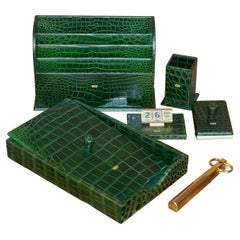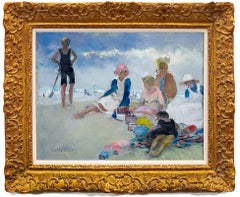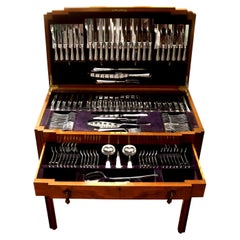Rolex Opener
20th Century English Art Deco Desk Sets
Gold
People Also Browsed
1810s Figurative Paintings
Board, Oil
Vintage 1930s English Art Deco Sterling Silver
Sterling Silver
Antique Early 1900s American Art Nouveau Table Lamps
Bronze
20th Century French Table Clocks and Desk Clocks
Enamel, Gold
20th Century English Georgian Tableware
Silver, Sterling Silver
20th Century Modern Portrait Paintings
Linen, Pastel
Late 19th Century Impressionist Figurative Paintings
Panel, Oil
20th Century American Impressionist Paintings
Canvas, Oil
2010s French Art Deco Table Lamps
Marble, Metal
Antique 18th Century English Other Historical Memorabilia
Mahogany
Antique 1840s English Vases
Porcelain
Antique 16th Century Indian Jewelry Boxes
Silver
Antique Early 1900s American Art Nouveau Table Lamps
Bronze
Antique Mid-19th Century British Victorian Tea Sets
Silver
Vintage 1910s American Art Nouveau Table Lamps
Bronze
20th Century French Baroque Fireplaces and Mantels
Malachite, Ormolu
Asprey & Garrard Limited for sale on 1stDibs
The first official Crown Jeweler for the British royal family, Garrard & Co. Limited has crafted iconic and historically celebrated rings, watches, necklaces and other jewelry for centuries.
Garrard Co. Ltd registered its current name in 1909 and, despite a temporary merger and relocation with Asprey, the firm still operates out of its original location on Albermarle St. in London. It was acquired by American private equity firm Yucaipa Companies in 2006.
Master silversmith George Wickes founded Garrard in 1735 and quickly gained a regal platform with patronage from Frederick, Prince of Wales. The company underwent a range of name changes and shifts in leadership over the years, with Robert Garrard becoming a partner in 1792. He assumed sole control of the firm a decade later and eventually passed the company down to his sons — James, Sebastian and Robert Garrard II — where it would remain in the Garrard family until 1946 with the death of Robert’s great-grandson.
Garrard created silver, tableware and decorative objects for the royal family as well as the Crown Jewels for a range of coronations beginning with King Edward VII’s in 1902. The esteemed luxury house created Queen Victoria's Small Diamond Crown, which featured colorless stones and was suitable to be worn while she mourned the passing of her last husband, Prince Albert. Later, for the coronation of Queen Elizabeth II in 1953, Garrard provided a pair of gold armlets. The company’s 1893 Girls of Great Britain and Ireland tiara adorns Queen Elizabeth II on British banknotes.
Among Garrard’s best known works is undoubtedly Princess Diana’s engagement ring — a 12-carat blue sapphire surrounded by 14 diamonds, set in 18-karat white gold. Unlike most royal engagement rings, the one Princess Diana chose wasn’t a one-of-a-kind piece commissioned from the Crown Jeweler, but rather a catalog offering for anyone who could swing the $60,000 price tag. As a result, this was a matter of controversy within the royal family. It is now Kate Middleton’s ring.
Garrard is committed to ethical sourcing and sustainable practices. Today, its all-female design team — led by creative director Sara Prentice — continues to merge ageless techniques with modern technology to uphold the firm’s legacy in the creation of precious handcrafted engagement rings, brooches and other adornments.
While Garrard and the royal family parted ways in 2007, the house still produces pieces that captivate new generations of jewelry wearers all over the world, just as it has for hundreds of years.
Find antique Asprey & Garrard Limited jewelry and furniture on 1stDibs.
A Close Look at art-deco Furniture
Art Deco furniture is characterized by its celebration of modern life. More than its emphasis on natural wood grains and focus on traditional craftsmanship, vintage Art Deco dining chairs, tables, desks, cabinets and other furniture — which typically refers to pieces produced during the 1920s and 1930s — is an ode to the glamour of the “Roaring Twenties.”
ORIGINS OF ART DECO FURNITURE DESIGN
- Emerged in the 1920s
- Flourished while the popularity of Art Nouveau declined
- Term derives from 1925’s Exposition Internationale des Arts Décoratifs et Industriels Modernes (International Exhibition of Modern Decorative and Industrial Arts) in Paris, France
- Informed by Ancient Egypt, Cubism, Futurism, Louis XVI, De Stijl, modernism and the Vienna Secession; influenced Streamline Moderne and mid-century modernism
CHARACTERISTICS OF ART DECO FURNITURE DESIGN
- Bold geometric lines and forms, floral motifs
- Use of expensive materials such as shagreen or marble as well as exotic woods such as mahogany, ebony and zebra wood
- Metal accents, shimmering mirrored finishes
- Embellishments made from exotic animal hides, inlays of mother-of-pearl or ivory
ART DECO FURNITURE DESIGNERS TO KNOW
VINTAGE ART DECO FURNITURE ON 1STDIBS
Few design styles are as universally recognized and appreciated as Art Deco. The term alone conjures visions of the Roaring Twenties, Machine Age metropolises, vast ocean liners, sleek typography and Prohibition-era hedonism. The iconic movement made an indelible mark on all fields of design throughout the 1920s and ’30s, celebrating society’s growing industrialization with refined elegance and stunning craftsmanship.
Widely known designers associated with the Art Deco style include Émile-Jacques Ruhlmann, Eileen Gray, Maurice Dufrêne, Paul Follot and Jules Leleu.
The term Art Deco derives from the name of a large decorative arts exhibition held in Paris in 1925. “Art Deco design” is often used broadly, to describe the work of creators in associated or ancillary styles. This is particularly true of American Art Deco, which is also called Streamline Moderne or Machine Age design. (Streamline Moderne, sometimes known as Art Moderne, was a phenomenon largely of the 1930s, post–Art Nouveau.)
Art Deco textile designers employed dazzling floral motifs and vivid colors, and while Art Deco furniture makers respected the dark woods and modern metals with which they worked, they frequently incorporated decorative embellishments such as exotic animal hides as well as veneers in their seating, case pieces, living room sets and bedroom furniture.
From mother-of-pearl inlaid vitrines to chrome aviator chairs, bold and inventive works in the Art Deco style include chaise longues (also known as chaise lounges) and curved armchairs. Today, the style is still favored by interior designers looking to infuse a home with an air of luxury and sophistication.
The vintage Art Deco furniture for sale on 1stDibs includes dressers, coffee tables, decorative objects and more.
Finding the Right desk-accessories for You
Whether you’ve carved out a space for a nifty home office or you prefer the morning commute, why not dress up your desk with antique and vintage desk accessories? To best tiptoe the line between desk efficiency and desk enjoyment, we suggest adding a touch of the past to your modern-day space.
Desks are a funny thing. Their basic premise has remained the same for quite literally centuries: a flat surface, oftentimes a drawer, and potentially a shelf or two. However, the contents that lay upon the desk? Well, the evolution has been drastic to say the least.
Thank the Victorians for the initial popularity of the paperweight. The Industrial Revolution offered the novel concept of leisure-time to Europeans, giving them more time to take part in the then crucial activity of letter writing. Decorative glass paperweight designs were all the rage, and during the mid-19th-century some of the most popular makers included the French companies of Baccarat, St. Louis and Clichy.
As paper was exceedingly expensive in the early to mid-19th-century, every effort was made to utilize a full sheet of it. Paper knives, which gave way to the modern letter opener, were helpful for cutting paper down to an appropriate size.
Books — those bound volumes of paper, you may recall — used to be common occurrences on desks of yore and where there were books there needed to be bookends. As a luxury item, bookend designs have run the gamut from incorporating ultra-luxurious materials (think marble and Murano glass) to being whimsical desk accompaniments (animal figurines were highly popular choices).
Though the inkwell’s extinction was ushered in by the advent of the ballpoint pen (itself quasi-obsolete at this point), there is still significant charm to be had from placing one of these bauble-like objets in a central spot on one’s desk. You may be surprised to discover the mood-boosting powers an antique — and purposefully empty — inkwell can provide.
The clamor for desk clocks arose as the Industrial Revolution transitioned labor from outdoors to indoors, and allowed for the mass-production of clock parts in factories. Naturally, elaborate designs soon followed and clocks could be found made by artisans and luxury houses like Cartier.
Find antique and vintage desk accessories today on 1stDibs.


